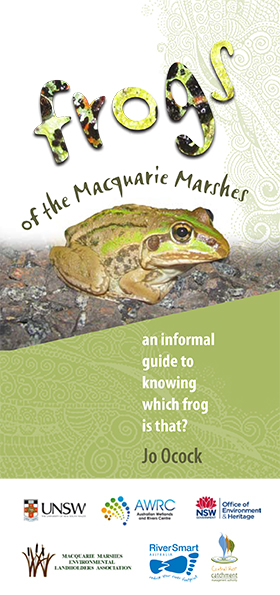My research interests are in field-based amphibian and wetland ecology and conservation, particularly in large floodplain systems in dryland Australia. I am fascinated by how large-scale ecological processes are influenced by an individual’s movement, behavioral patterns and physiology, and how this translates to species vulnerability to threatening processes such as river regulation, disease and urban development.
My PhD research was focused on establishing the relationship between various frog species and the flow regime of wetlands in the northern Murray Darling Basin. I carried out fieldwork in the Macquarie Marshes, north of Dubbo, for three seasons, including the largest flood in a decade (September 2010 to February 2011). A number of my findings have been already implemented into monitoring and management of environmental water in the Marshes. In late 2013, I became involved in assessing ecological responses to environmental water across numerous biota, including fish and aquatic vegetation in the Murrumbidgee river catchment, with Charles Sturt University. Part of this work investigated options for management of floodplain wetlands in the Murrumbidgee to encourage persistence and increase recruitment of frogs, particularly for the endangered southern bell frog (Litoria raniformis). I then worked as an environmental scientist with the Water and Wetlands Team (Science Division), at the Office of Environment and Heritage, NSW. Here I assisted coordination of wetland fauna monitoring in NSW Murray Darling Basin (MDB) wetlands as part of the ‘water for the environment‘ program. Currently, I’m a project conservation officer for NSW National Parks and Wildlife Service, mostly focussed on improving management of our wetland reserves within the NSW MDB.
Originally hailing from Christchurch, New Zealand (“the flattened city”), I completed a Bachelor of Science (Biology) and a Bachelor of Law at the University of Canterbury (2000 – 2004). During this time, I became involved in a captive management programme for New Zealand’s native frogs, Leiopelma spp., which is where my love for frogs began. After I completed my degree, I headed for the UK, where I detoured from frogs while I worked as project coordinator on the Mongolian Biodiversity Databank and Conservation Assessment Project, with the Zoological Society of London (ZSL). For this, I was based at London Zoo and spent six weeks in Mongolia where we held a workshop to assess the conservation status of Mongolian mammals and fishes. It was a fascinating project and I got to work with inspiring people, both from ZSL and Mongolian researchers. When this finished, I headed straight back to the ‘frog life’, and then spent five months in Thailand working as a field assistant for Jennifer Sheridan on a project looking at tropical amphibian breeding biology. Counting frogs by night and frog eggs by day, and eating amazing Thai food in between, it was a fantastic experience!
Ending back in New Zealand, I found myself working for the Freshwater Ecology Research Group at the University of Canterbury, surveying braided rivers and urban streams, and counting the macroinvertebrates that inhabited them. I then undertook a Masters of Conservation Biology which took me to the Centre for Ecosystem Science, at the University of New South Wales, and my first trip out to the Macquarie Marshes — a place which was to steal my heart. By the end of this course, it seemed like a good idea to everyone, including myself that I should carry out a PhD on the frogs of the Marshes. Turned out it was a good idea. There were lots of frogs, some floods and it rained occasionally. The rest, they say, is history.

